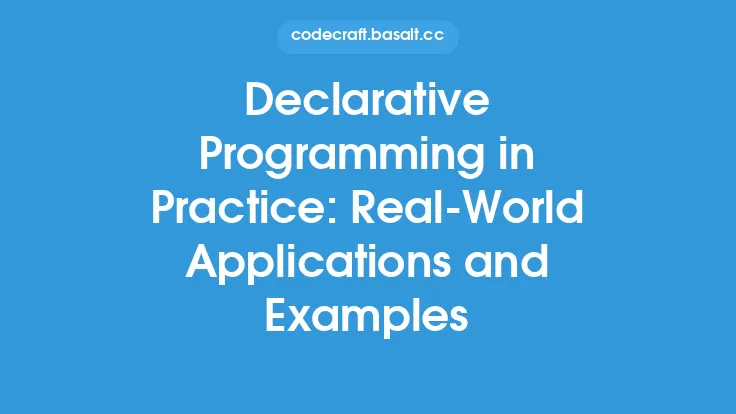When developing and deploying machine learning models for real-world applications, evaluating their performance is crucial to ensure they meet the desired standards and provide reliable results. Model evaluation is a critical step in the machine learning lifecycle, as it helps to identify the strengths and weaknesses of a model, compare different models, and select the best one for a specific task. However, evaluating models for real-world applications poses several challenges and considerations that need to be addressed.
Introduction to Model Evaluation
Model evaluation involves assessing the performance of a machine learning model on a given task, using various metrics and methods. The goal of model evaluation is to estimate the model's ability to generalize to new, unseen data, and to identify potential issues, such as overfitting or underfitting. In real-world applications, model evaluation is often more complex than in academic or research settings, as it requires considering additional factors, such as data quality, noise, and variability, as well as the model's interpretability, explainability, and transparency.
Challenges in Model Evaluation
Evaluating models for real-world applications poses several challenges. One of the main challenges is the lack of a single, universally accepted metric for evaluating model performance. Different metrics, such as accuracy, precision, recall, F1-score, mean squared error, and R-squared, are suitable for different tasks and applications, and the choice of metric depends on the specific problem and requirements. Additionally, models may be evaluated on multiple metrics, which can lead to trade-offs and conflicting objectives. For instance, a model may be optimized for accuracy but may not perform well on other metrics, such as fairness or robustness.
Another challenge in model evaluation is the presence of noise and variability in real-world data. Real-world data is often noisy, missing, or inconsistent, which can affect the model's performance and make it difficult to evaluate its true capabilities. Furthermore, data distributions can change over time, which requires models to be adaptive and robust to concept drift. Model evaluation methods need to account for these challenges and provide a realistic estimate of the model's performance in real-world scenarios.
Considerations for Model Evaluation
When evaluating models for real-world applications, several considerations need to be taken into account. One of the key considerations is the choice of evaluation protocol. Common evaluation protocols include holdout, cross-validation, and bootstrapping, each with its strengths and weaknesses. The choice of protocol depends on the size and quality of the available data, as well as the computational resources and time constraints.
Another important consideration is the evaluation of model uncertainty and robustness. Real-world applications often require models to provide uncertainty estimates or confidence intervals, which can be used to inform decision-making and risk assessment. Model uncertainty can be evaluated using various methods, such as Bayesian neural networks, Monte Carlo dropout, or bootstrapping, which provide a measure of the model's uncertainty and robustness to different scenarios and inputs.
Evaluating Model Performance in Real-World Scenarios
Evaluating model performance in real-world scenarios requires considering the specific requirements and constraints of the application. For instance, in medical diagnosis, models need to be evaluated on their ability to detect diseases accurately and provide reliable predictions, while in finance, models need to be evaluated on their ability to predict stock prices or credit risk. In addition to accuracy, models may need to be evaluated on other metrics, such as fairness, transparency, and explainability, which are critical in high-stakes applications.
Real-world applications also require models to be evaluated in the presence of concept drift, which refers to changes in the data distribution over time. Models need to be adaptive and robust to concept drift, which can be achieved through online learning, incremental learning, or transfer learning. Evaluating model performance in real-world scenarios also requires considering the availability of data, computational resources, and time constraints, which can affect the choice of evaluation protocol and metrics.
Best Practices for Model Evaluation
To ensure reliable and accurate model evaluation, several best practices need to be followed. One of the key best practices is to use a holdout set or a separate test set to evaluate the model's performance, rather than using the training data or a single metric. This helps to prevent overfitting and provides a more realistic estimate of the model's performance in real-world scenarios.
Another best practice is to use multiple metrics and evaluation protocols to assess the model's performance from different perspectives. This helps to identify potential issues, such as overfitting or underfitting, and provides a more comprehensive understanding of the model's strengths and weaknesses. Additionally, models should be evaluated on their ability to generalize to new, unseen data, which requires using techniques such as cross-validation or bootstrapping.
Conclusion
Model evaluation is a critical step in the machine learning lifecycle, and it poses several challenges and considerations in real-world applications. Evaluating models requires considering multiple metrics and evaluation protocols, as well as the specific requirements and constraints of the application. By following best practices, such as using a holdout set and multiple metrics, and considering the challenges and considerations of model evaluation, developers can ensure that their models provide reliable and accurate results in real-world scenarios. As machine learning continues to play an increasingly important role in various industries and applications, the importance of model evaluation will only continue to grow, and it is essential to develop and deploy models that are robust, reliable, and transparent.





